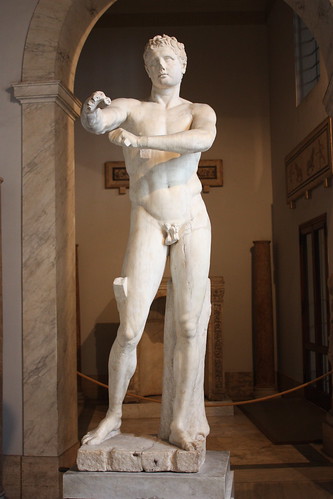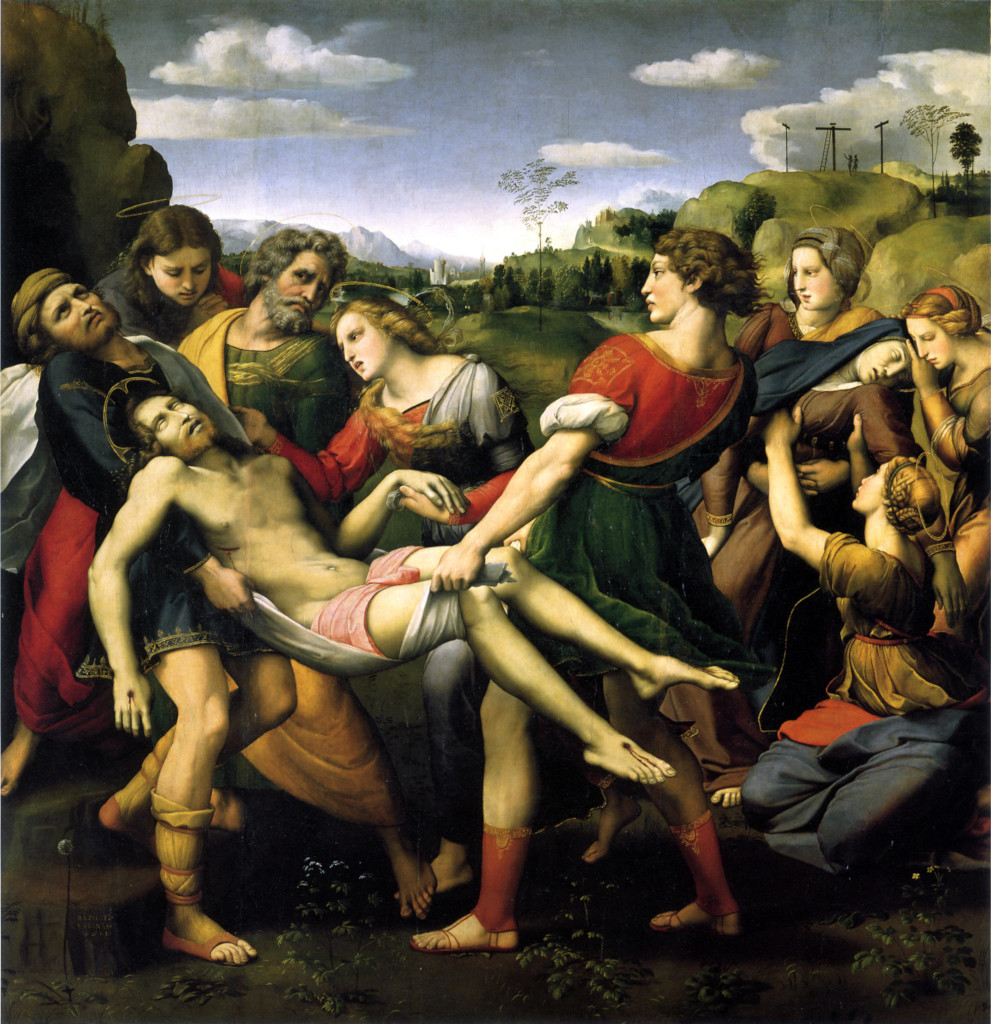December 28, 2006
Francis Cunningham Patrick (1973-75), oil on linen, 80 x 44 in.
What appears on my canvas is not the result of copying nature. It is the product of a painterly process of decision-making, one that abstracts from the visual appearance of the figure and coordinates this information with the actual proportional relationships of the anatomical parts of the model’s body.
What our eyes see and what is actually there are not at all the same. Your eye may tell you that the hand coming toward you is larger than the head behind it – the camera gives proof – but your mind knows that the hand is smaller, and by how much.
The model in front of you may be lit by more than a single light source, perhaps by as many as four or five, but if you want the body’s forms to read as three-dimensional you will select a single light source and you will then light the geometrical form-concepts that mass the model’s anatomical parts by means of this single light source. All of this is knowledge, conceptual and generalized information which the artist brings to bear on the appearance of the particular model. What we “see” is a combination of seeing and knowing.
In taking up the nude today, what is the difference between now and what was done in the past? The short answer is a world. The disappearance of the classical world view has opened up for us a new world of possibilities in terms of the ways in which a human being moves and the meaning of gestures, and also in the means for creating three-dimensional form and space.
Jean Auguste Dominique Ingres La Grande Odalisque (1814), 35 x 64 in.
Classical art from antiquity through the 19th century was concerned primarily with ideal or idealized proportions, rhythms, pictorial organization and also with generalized color. The figures work as art, but how many classical or classicized figures do you know that can actually take a pose other than the one in which they are positioned? You may ask why would anyone want a painted or sculpted figure to be in any other position than the one they are in? Why should a painted or sculpted figure be anatomically functional and able to move about, change positions and take other poses? The answer to this is that in accepting the model as a functioning human being rather than just a painted or sculpted depiction, a whole new set of possibilities for understanding the human being, physically, mentally and spiritually, opens up – possibilities that were closed to the classical outlook.
Francis Cunningham Regina Reclining (2003-05), oil on linen, 32 x 65 in.
Francis Cunningham Genay Sundra Reclining (1997-99), oil on linen, 40 x 72 in.
How many depictions in classical painting and sculpture are other than theatrical, operatic statements of the “mad, sad, glad” of human emotions, as the chorographer Alwin Nikolais called them? Piero della Francesca’s silence is no less ideal in its effect – a theater of the ineloquent.
Piero della Francesca St. John the Evangelist (1454-1469), tempera on poplar panel, 52 3/4 x 24 1/2 in. The Frick Collection.
As an experiment, take Raphael’s Entombment and examine it for probability and expenditure of effort in relationship to the movement and gestures required by the action.
Raphael The Entombment (1507), oil on panel, 184 × 176 cm. Galleria Borghese, Rome.
Take each pose for yourself. You will not be able to. [I have had students prove this to themselves.] With this exercise in hand, examine the Sistine Ceiling and the Last Judgment of Michelangelo, the figures in Delacroix’s Death of Sardanapalus and Gericault’s Raft of the Medusa, with its Michelangeloesque poses in a carefully composed pyramid.
Michelangelo The Sistine Ceiling; Cumaean Sibyl (detail).
Michelangelo The Last Judgment; St. Bartholomew (detail).
Delacroix Death of Sardanapalus (1827); detail.
Gericault’s Raft of the Medusa; detail.
Praxiteles Aphrodite
The classical mindset from antiquity through the 19th century limited the possibilities of the nude to a small number of gestures and poses – these poses constitute the classical nude, as Kenneth Clark has described them in The Nude: A Study in Ideal Form.
Continues in part 2/3














Mastery shows itself within strict limits ... according to Goethe
ReplyDeleteFrom Margaret Beels:
ReplyDeleteI think the Nude essay is smashing,
writing, thought and the choice and use of reproductions. An added
plus, reclining Mimi next to reclining Regina. Lots to think about
and to take with me to the museum. I have just finished reading
Clark's THE NUDE for the third time, and am fascinated by his opinion
of Renoir which I didn't take in the first two times and am thinking
about where Lucien Freud fits into all of this. Having the
Cunninghams in the computer in this form is a great gift. Thank you,
Dick.
love, Margaret
thank you. perke
ReplyDeleteGGGGGGGGGGGGGGGGGGGGGGGGGGGGGGGGGGGGGGGGGGGGGGGGGGGGGGGGGGGGGGGGGGGGGGGGGGGGGGGGGGGGGGGGGGGGGGGGGGGGGGGGGGGGGGGGGGGGGGGGGGGGGGGGGGGGGGGGGGGGGGGGGGGGGGGGGRRRRRRRRRRRRRRRRRRRRRRRRRRRRRRRRRRRRRRRRRRRRRRRRRRRRRRRRRRRRRRRRRRRRRRRRRRRRRRRRRRRRROOOOOOOOOOOOOOOOOOOOOOOOOOOOOOOOOOOOOOOOOOOOOOOOOOOOOOOOOOOOOOOOOOOOOOOOOOOOOOOOOOOOOOOOOOOOOOOOSSSSSSSSSSSSSSSSSSSSSSSSSSSSSSSSSSSSSSSSSSSSSSSSSSSSSSSSSSSSSSSSSSSSSSSSSSSSSSSSSSSSSSSS!!!!!!!!!!!!!!!!!!!!!!!!!!!!!!!!!!!!!!!!!!!!!!!!!!!!!!!!!!!!!!!
ReplyDeleteYUUUUUUUUUUUUUUUUUUUUUUUUUUUUUUUUUUUUUUUUUUUUUUUUUUUUUUUUUUUUUCCCCCCCCCCCCCCCCCCCCCCCCCCCCKKKKKKKKKKKKKKKKKKK
ReplyDelete